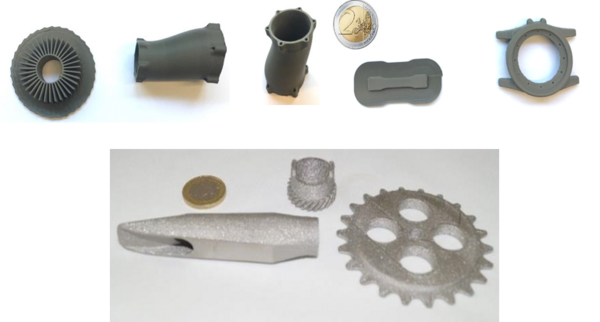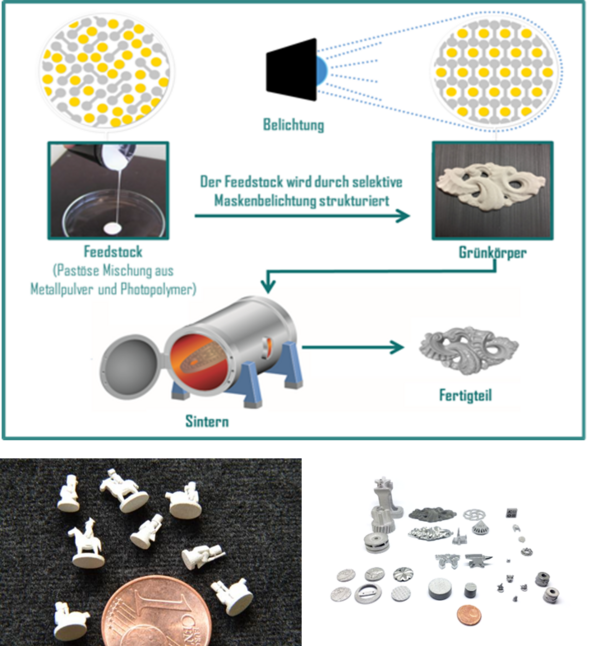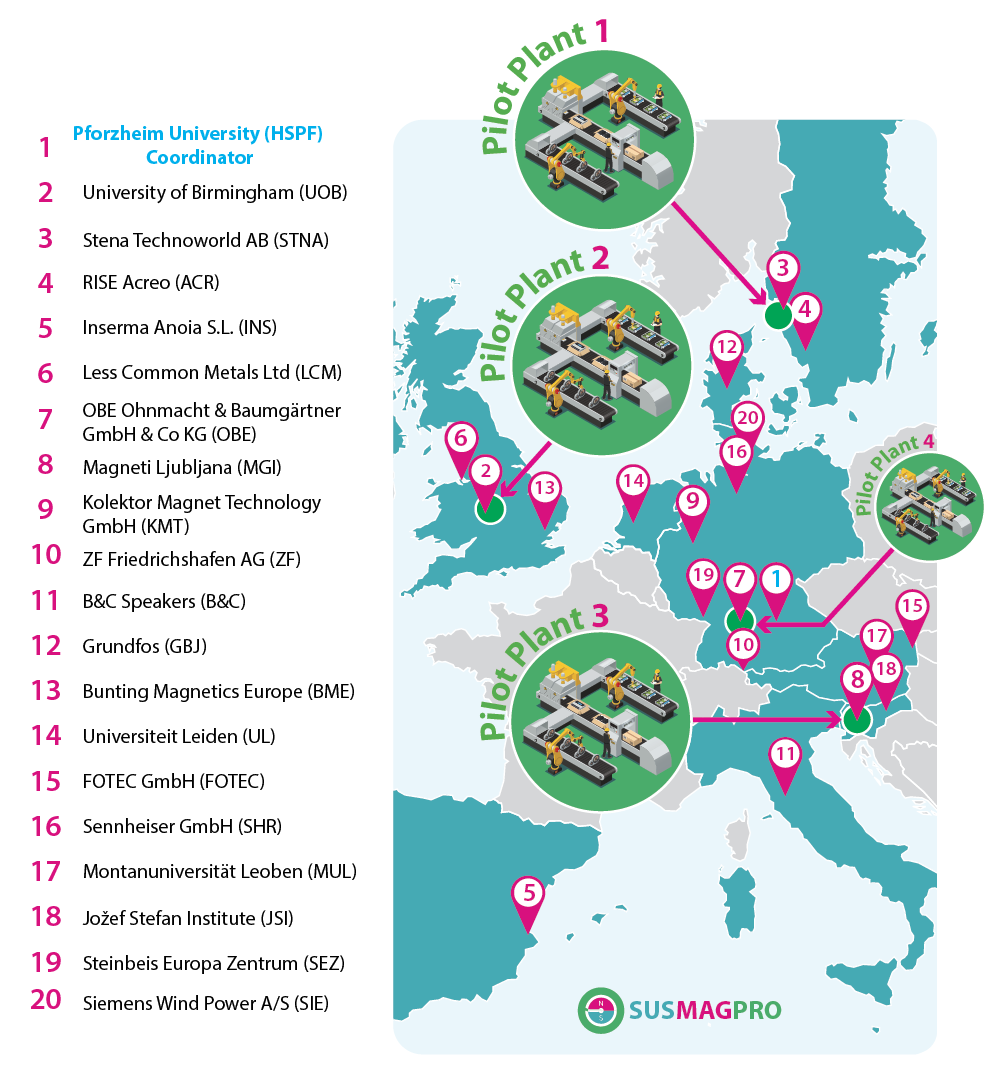Development, characterisation and recycling of high-performance magnets based on rare earths
“Rare earths" not only play a key role in the implementation of electro mobility and a renewable energy supply; the entire European high-tech industry is heavily dependent on the supply of raw materials from China, which currently controls over 90% of global production. The market for rare earths has been uniquely turbulent in recent years. Overall, although the prices of most of the strategic metals have fallen significantly since 2012, British market analysts, for example, expect the market for electric and hybrid vehicles to grow by 400% in the next ten years, with a corresponding increase in demand for magnetic metals such as dysprosium, terbium and neodymium.
The research activities of the STI are concerned with the development of new production processes for the manufacture of high-precision permanent magnets for sensor, motor and generator applications based on neodymium. A strong focus here is on the use of recycled rare earths from electronic scrap such as computer hard disks in order to significantly reduce the dependence of magnet production on scarce and valuable raw materials.
Currently implemented third-party funded projects:
A novel circular economy for sustainable RE-based magnets
Duration: 01.05.2018 - 30.04.2021
Total grant amount EUR 1,056,380, of which EUR 365,922 for the STI
Although the alloying elements of rare earth-based permanent magnets (SE) are classified as critical raw materials in the EU, there is currently no industrially functioning recycling/recirculating economy for this group of materials. Under the assumption that the demand will double in the next 10 years, this problem will become even worse.
The only recycling method currently available is the shredding of electronic scrap with subsequent chemical and pyrometallurgical recycling. This is expensive and energy-intensive, and the quality of the magnets to be recycled varies greatly.
MaXycle's project goal is therefore to develop a significantly more environmentally friendly, 'abbreviated' reprocessing method for NdFeB magnets:
- Definition of standardized quality criteria for EOL magnets and development of a classification system for the contamination level of magnets.
- Development of a marking system for newly manufactured RE magnets to identify different magnet types and qualities.
- Development of methods to remove coatings and adhesive residues from EOL magnets easily and cost-effectively
- Methods for improving the magnetic properties of recycling magnets by selective adjustment of microstructure and phase composition, and
- Consideration of the industrial suitability for large series production including a comprehensive consideration of the life cycle assessment.
MaXycle thus makes a significant contribution to increasing today's very low recycling rates, which are mainly due to low take-back rates and poor interface management between logistics, mechanical comminution and metallurgical recovery, with the aim of increasing the current recycling rate by more than 90% and thus creating a sustainable, secondary raw material source for SE magnets, reducing dependence on non-EU suppliers and at the same time creating new markets and jobs in the EU in the field of recycling and production of SE magnets.
Sustainable Magnets Production
Duration: 01.06.2019 - 31.05.2022
Total grant amount € 12,977,446, of which are € 2,088,000 for the STI.
SUSMAGPRO is an industrialization project to provide 4 recycling and remanufacturing plants for End-of-Life (EOL) magnets with an initial capacity of 110 t/a throughout Europe.
The fact that Europe has very few usable rare earths (SE) for its high technology industries makes them the most important raw materials for integration into the recycling economy. The European industry needs about 2,000-3,000 t/a of rare earths, all of which have to be imported. At the same time, the current recycling rate of < 1% is negligible. In all respects, therefore, the recovery, processing and reuse of permanent magnets is the only viable way to ensure adequate security of supply for important sectors such as automotive, aerospace, electric vehicles, e-bikes, wind turbines and a wide range of consumer goods.
The SUSMAGPRO project is developing the infrastructure to recover the many tonnes of magnets already imported into Europe in millions of devices, rather than dumping this critical resource in landfills or exporting it to other parts of the world at the end of the product life cycle.
The processing routes implemented in 4 pilot plants cover the entire value chain, from robot-assisted sorting, separation and magnet/alloy production to new permanent magnets made from recycled material. This will allow the EU to better enter the global markets for renewable energy system (RES) equipment and to enable carbon-free mobility and energy.
New magnetic materials through additive manufacturing
Duration: 01.05.2019 - 30.04.2020
Total grant amount: 129,900 €, of which are 60,900 € for the STI
The rapidly accelerating electrification of broad areas and the progressive expansion of renewable energy require efficient energy conversion machines. Material-, energy- and resource-efficient energy conversion machines require powerful, cost-effective and durable permanent magnets in the rotor. However, the strong rare earth magnets favoured today are associated with increased costs due to the strategically critical rare earth metals they contain. A promising approach is the research and development of permanent magnets of assured quality tailored to the system requirements. Here, the use of new innovative manufacturing technologies such as additive manufacturing promises many new perspectives. The additive production of (plastic-free) permanent magnets is breaking new scientific ground.
The overall goal of the project is to investigate and evaluate the possibilities of various innovative generative manufacturing processes for the realization of new permanent magnet materials in order to break new ground in the future in the product development and design of efficient electrical energy converters with this important class of materials. The focus is on a comprehensive screening of promising innovative approaches and processes. The screening is carried out by testing laser-based and lithography-based additive manufacturing on a laboratory scale with equipment already set up for this purpose. The results obtained are evaluated against the background of the feasible magnetic properties and quality of the components, taking into account economic aspects.
Thus, ADMIRAL can make valuable contributions to materials research in the fields of electromobility, energy research and industry4.0 and their sustainable establishment, which is of great social interest due to the associated reduction of CO2 emissions and the unstoppable digitisation.
Additive manufacturing of precision metal components
The manufacturing processes grouped together under the generic term "additive manufacturing", whose common feature is the layer-by-layer construction of component structures, are characterized by material efficiency and high final contour proximity. Direct implementation of designs from a CAD data model without the additional need for component-specific devices or tools makes additive manufacturing processes particularly interesting for the production of prototypes and small series.
In principle, the attractiveness of additive manufacturing processes increases with increasing component complexity and/or difficult machinability and/or high basic price of the material used.
On the other hand, many questions are still open with regard to mechanical requirements or application limits, component distortion, surface quality, reproducibility or suitability for series production, and especially production costs, which make further development efforts necessary.

The STI is working on this novel manufacturing process, which is essentially based on a combination of Metal Injection Moulding Technology (MIM) with the printing process of material extrusion (also known as "Fused Deposition Modelling"). In this process, a green compact is produced from a special, metallically highly filled polymer filament on a modified 3D printer. Analogous to the MIM process, the subsequent process steps of debinding and sintering first remove the polymer components in the green body and then convert the metal particles into a high-density, pore-free structure.
The advantages of this process are the low cost of the printer and the very simple change of material. However, the surfaces of the components have a typical corrugated structure and the process is only suitable for medium to large components (approx. 30 to 200g component weight) with moderate tolerance requirements. The STI is working on the optimisation of the process to produce components with improved surface properties and material development (especially stainless steels, titanium and copper materials).

LMM (Lithography based Metal Manufacturing) is a novel additive manufacturing process based on digital light processing, which has been specially developed for processing metallic powders. In this process, a light-curing resin, which forms a suspension with the metal powder, is cured by means of UV light. After exposure, the building platform is lowered and a green body is built up layer by layer, which is then debound and sintered. This produces pure metal components with mechanical properties comparable to those of machined materials.
The LMM process is characterized by excellent surface quality, precision and material variety and allows the processing of non-weldable materials (e.g. hard metals, steels with high carbon content etc.). In contrast to manufacturing with Powder Bed Fusion (Laser Sintering/SLM), the most widely used additive process for metallic components on the market, the LMM process does not generate any thermal stresses that could lead to cracks in the component. Furthermore, this innovative process does not require any additional support structures for the printing process, which in other processes usually have to be removed manually afterwards, which is a time-consuming process.
STI owns the first LMM prototype printer available on the market and is engaged in process and material development for stainless steels, titanium materials and precious metals.


